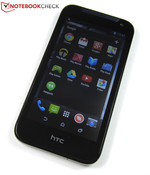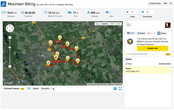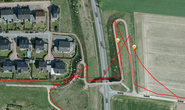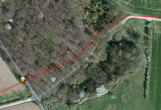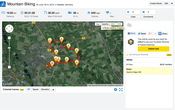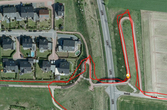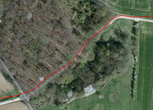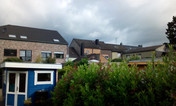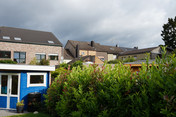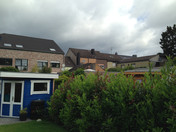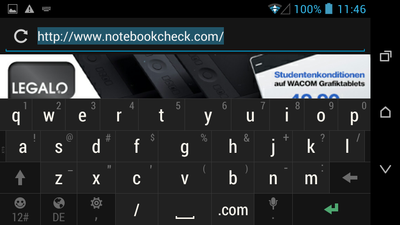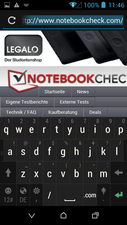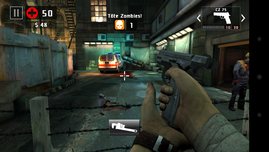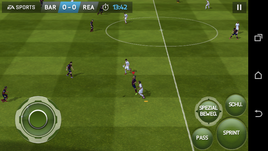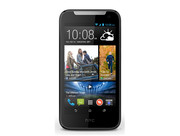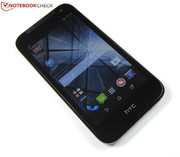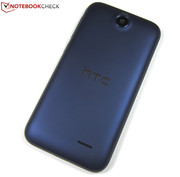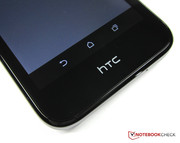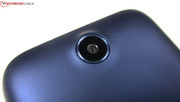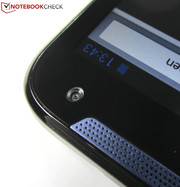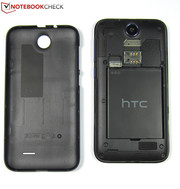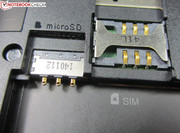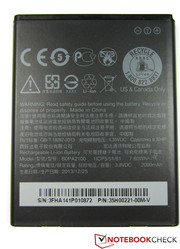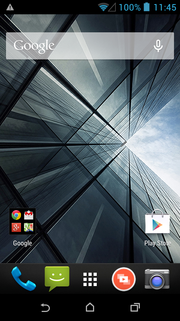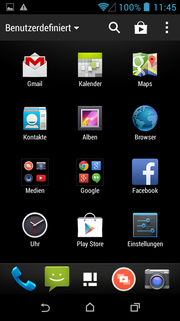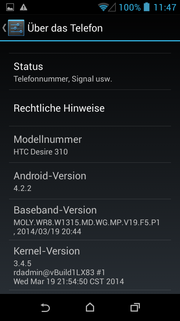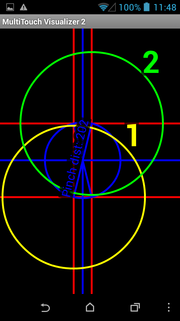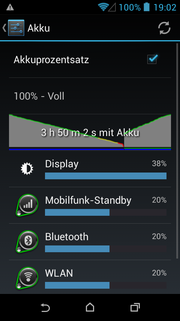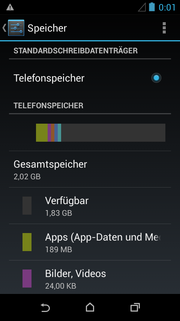HTC Desire 310 Smartphone Review

For the original German review, see here.
HTC's Desire 310 had its debut shortly after the Mobile World Congress in Barcelona. Was it too ordinary for the mobile industry exhibition? In any case, the 4.5-inch Android smartphone is not a top dog or an eye-catcher like Apple's iPhone 5 or Nokia's Lumia 1520. It clearly caters to the entry-level sector. HTC's phone is available for just around 140 Euros (~$191) in online shops, which is quite impressive for a smartphone with a 4.5-inch screen. However, buyers of the Desire 310 will have to make compromises in configuration. Its low 4 GB of storage capacity is reduced to just below 2 GB in operation. The screen's resolution of 854x480 pixels is not exactly high, and the somewhat older Android 4.2 operating system powers the phone. However, HTC's smartphone sports a quad-core SoC in the form of MediaTek's MT6582M, which easily takes care of routine tasks. That is completed by a 5-megapixel primary camera and, with exception of LTE, all the important mobile network technologies.
Case
HTC packs the Desire 310 in a rigid plastic casing that impresses with a very stiff build, and that additionally collects bonus points for design owing to its rounded corners. The casing's removable back features a light rubber-coating and provides the fingers with a very secure grip. Interestingly, the glass surface seamlessly integrated into the chassis shows considerably more resistance than the back cover. With a height of just over 11 millimeters, the Desire 310 is a bit thicker than similarly equipped smartphones of the same size. Kazam's Thunder Q4.5 (8.9 millimeters), Huawei's Ascend Y530 (9.3 millimeters), and LG's L70 (9.6 millimeters) are all thinner.
Connectivity
HTC's Desire 310 relies on a quad-core SoC in the form of MediaTek's MT6582M. Its computing cores clock with a speed of 1.3 GHz. The ARM Mali-400 MP2 graphics chip is installed. In addition to 1 GB of DDR3 RAM, 4 GB of storage capacity is installed. However, over 2 GB has to be deducted from that for Android 4.2 and the preloaded apps. Thus, only 1.8 GB is left for personal applications and data. The storage capacity can be increased by up to 32 GB via the micro-SD slot.
Software
The now slightly older Android 4.2 version powers the Desire 310. HTC, however, installs its BlinkFeed feature on the smartphone. It displays the latest news and streams, as well as updates from social networks clearly arranged on the home screen. In addition to various Google apps, such as Gmail, Maps, Drive and YouTube, a file manager and the Polaris Office 5 office suite are preloaded.
Communication & GPS
Users, who do not need LTE, will be quite satisfied with the Desire 310's communication features. In addition to Wi-Fi 802.11 b/g/n and Bluetooth 4.0 alongside aptX support, the smartphone also provides GSM quad-band (850/900/1800/1900 MHz) and UMTS tri-band (850/900/2100 MHz). Download speeds of up to 21.1 Mbps are possible via HSDPA. We did not experience disconnections or other interruptions during our tests.
The Desire 310 quickly found our current location with its GPS antenna, no matter whether we were in a building or outdoors. As the comparison with the Garmin Edge 500 navigation system proved on our over 10-kilometer long bike-test route, HTC's phone was often quite off track in terms of localization. Nevertheless, the GPS accuracy is absolutely sufficient for everyday use.
Telephony & Speech Quality
The speech and audio quality of HTC's Desire 310 is throughout good. That is equally true for calls to landlines and mobile network connections.
Cameras & Multimedia
The Desire 310 takes pictures with up to 2880x1728 pixels and records videos in the 1080p Full HD format with its 5-megapixel camera. The camera module in HTC's phone offers many setting options, such as exposure, white balance and ISO value. Its features include face and smile detection and HDR function. The webcam above the screen only provides VGA quality with 640x480 pixels, which is just still enough for selfies and video chats.
The picture qualities of the Desire 310 are relatively modest. Compared with good smartphone camera modules, the photos look low in contrast and, when looking closer, quite noisy and sometimes very blurred. Fine details are thus only difficult to see.
Accessories & Warranty
HTC includes a micro-USB cord, headset, and proprietary USB power supply for the Desire 310. The manufacturer offered the HTC battery pack and stereo headphones as accessories on its website at the time of writing. The Desire 310 comes with a 24-month warranty.
Input Devices & Controls
The capacitive touchscreen in HTC's Desire 310 responds promptly to commands and allows accurate control of applications and screen menus. The physical buttons (power button, volume rocker) and Android buttons function just as smoothly. A virtual QWERTY keyboard is available for typing. It covers half the screen at most in landscape mode, and thus quite a bit of the content can still be seen.
Display
The 4.5-inch TFT screen in HTC's Desire 310 displays 854x480 pixels and thus lags behind the resolution of numerous current smartphones. However, it quickly becomes clear that the FWVGA resolution or similar supported formats such as WVGA (800x480 pixels) are standard when compared with 4.0- and 4.5-inch entry-level phones. Nevertheless, the Desire 310's screen will have to accept criticism in another place.
With a brightness of 255.3 cd/m², the screen in HTC's phone is not exceptionally bright and even places itself with some distance from the comparison devices. The screen of LG's L70 is considerably brighter with 339.4 cd/m², and Kazam's Thunder Q4.5 remains unmatched with a brightness of 520.8 cd/m².
The Desire 310's illumination of 85%, black level of 0.50 cd/m², and contrast ratio of 544:1 do not give reason for complaint, although all three rates are only middling.
| |||||||||||||||||||||||||
Brightness Distribution: 85 %
Center on Battery: 272 cd/m²
Contrast: 544:1 (Black: 0.5 cd/m²)
ΔE Color 12.13 | 0.5-29.43 Ø5
ΔE Greyscale 14.77 | 0.57-98 Ø5.3
Gamma: 2.42
Our assessments with the X-Rite i1pro 2 colorimeter and CalMAN software show that the Desire 310's screen almost ideally displays red and green hues. However, blue colors are much too strong. This considerably throws HTC's phone out of balance, which leads to a very high DeltaE of 12.13. An even stronger shift is seen in the grayscale where most gray hues are very overemphasized (DeltaE of 14.77). The color temperature of 17097 K is also far too high. Seen subjectively, HTC's phone displays images impeccably despite these measured shifts.
A smartphone screen should have a minimum brightness of 200 cd/m² to unequivocally pass as suitable for daylight use. HTC's Desire 310 easily surpasses this hurdle with 255.3 cd/m² and can thus also be used in clear blue skies and sunlight with almost no problems. "Almost" because the intensely reflective and ultimately still fairly dark screen sometimes makes it difficult to recognize displayed content.
Viewing-angle stability is not one of the Desire 310's strengths. The entire content is inverted when looking on the smartphone from the left (where webcam, USB port, and audio jack are located). The image is not particularly convincing from other viewing angles either. The displayed colors start to fade when the HTC's screen is tilted just slightly. The screen's extremely reflective surface is yet another distracting factor.
Performance
Powered by MediaTek's MT6582M quad-core SoC and the ARM Mali-400 MP2 graphics chip, HTC's Desire 310 will not accomplish any pixel feats, but it does deliver a good system performance. The review sample finished the synthetic benchmarks just before the comparison phones. A sole exception was seen in 3DMark 2013 where it only managed last place.
| 3DMark - 1280x720 Ice Storm Standard Score (sort by value) | |
| HTC Desire 310 | |
| Huawei Ascend Y530 | |
| Kazam Thunder Q4.5 | |
| LG L70 | |
| Samsung Galaxy S Duos 2 GT-S7582 | |
| AnTuTu v4 - Total Score (sort by value) | |
| HTC Desire 310 | |
| Huawei Ascend Y530 | |
| Kazam Thunder Q4.5 | |
| LG L70 | |
| Samsung Galaxy S Duos 2 GT-S7582 | |
| Geekbench 3 - 32 Bit Multi-Core Score (sort by value) | |
| HTC Desire 310 | |
| Huawei Ascend Y530 | |
| Kazam Thunder Q4.5 | |
| LG L70 | |
| Samsung Galaxy S Duos 2 GT-S7582 | |
| PassMark PerformanceTest Mobile V1 - System (sort by value) | |
| HTC Desire 310 | |
| Huawei Ascend Y530 | |
| Kazam Thunder Q4.5 | |
| LG L70 | |
| Samsung Galaxy S Duos 2 GT-S7582 | |
It was almost a deadlock in the browser benchmarks. HTC's Desire 310 did not significantly surpass or lag behind its contenders here.
| Octane V2 - Total Score (sort by value) | |
| HTC Desire 310 | |
| Kazam Thunder Q4.5 | |
| LG L70 | |
| Samsung Galaxy S Duos 2 GT-S7582 | |
| WebXPRT 2013 - Overall (sort by value) | |
| HTC Desire 310 | |
| Kazam Thunder Q4.5 | |
| LG L70 | |
| Samsung Galaxy S Duos 2 GT-S7582 | |
| Peacekeeper - --- (sort by value) | |
| HTC Desire 310 | |
| Huawei Ascend Y530 | |
| Kazam Thunder Q4.5 | |
| LG L70 | |
| Samsung Galaxy S Duos 2 GT-S7582 | |
Like the write and read benchmarks show, the Desire 310 is faster than the comparison phones in some cases. That is particularly true in sequential read where HTC's phone manages an advantage of a whole 30%. However, the smartphone is not the fastest device in write operations and has to let Samsung's Galaxy S Duos 2 GT-S7582 pass by.
| AndroBench 3-5 | |
| Random Read 4KB (sort by value) | |
| HTC Desire 310 | |
| Huawei Ascend Y530 | |
| Kazam Thunder Q4.5 | |
| LG L70 | |
| Samsung Galaxy S Duos 2 GT-S7582 | |
| Random Write 4KB (sort by value) | |
| HTC Desire 310 | |
| Huawei Ascend Y530 | |
| Kazam Thunder Q4.5 | |
| LG L70 | |
| Samsung Galaxy S Duos 2 GT-S7582 | |
| Sequential Read 256KB (sort by value) | |
| HTC Desire 310 | |
| Huawei Ascend Y530 | |
| Kazam Thunder Q4.5 | |
| LG L70 | |
| Samsung Galaxy S Duos 2 GT-S7582 | |
| Sequential Write 256KB (sort by value) | |
| HTC Desire 310 | |
| Huawei Ascend Y530 | |
| Kazam Thunder Q4.5 | |
| LG L70 | |
| Samsung Galaxy S Duos 2 GT-S7582 | |
Games
Emissions
Temperature
Although the chart displays a reddish color, the operating temperatures of HTC's phone range within an acceptable field. The smartphone's temperature increased to just below 40 °C during load. However, this did not make the Desire 310 uncomfortable to hold. Its maximum idle of 32.4 °C is an exemplary rate.
(+) The maximum temperature on the upper side is 38.5 °C / 101 F, compared to the average of 35 °C / 95 F, ranging from 21.9 to 56 °C for the class Smartphone.
(+) The bottom heats up to a maximum of 39.7 °C / 103 F, compared to the average of 33.8 °C / 93 F
(+) In idle usage, the average temperature for the upper side is 30.4 °C / 87 F, compared to the device average of 32.7 °C / 91 F.
Speakers
The nature of smartphone speakers are not a revelation for audiophile users. As expected, the small speaker on the back of HTC's Desire 310 does not manage to reverse this trend. At least the small speaker still does exactly what it is meant to do. It renders speech, music and other tones in good quality. Furthermore, it does not distort even in maximum volume. The included stereo headset produces a considerably better sound though.
Energy Management
Power Consumption
HTC's Desire 310 thwarted any plans to measure its power consumption. The Voltcraft SL-451 ammeter that we normally use for this test always displayed just above zero no matter what load was applied to the smartphone. Since we can exclude a malfunction of our ammeter, we can only estimate the Desire 310's power consumption by comparing it with the contenders. The compared smartphones consume between 2.0 and 3.3 watts when idling. The battery runtimes show that the Desire 310 is considerably more moderate with the available energy.
Battery Runtime
HTC's Desire 310 impresses with long battery runtimes. The entry-level smartphone achieved a good 9 hours and 2 minutes in the practical Wi-Fi test, using a screen brightness of 150 cd/m², enabled energy-saving features, and websites opened every 40 seconds via a script. Thus, the Desire 310 should manage a whole day of routine use. The comparison phones are not as enduring, although LG's L70 (8 hours, 39 minutes) and Huawei's Ascend Y530 (8 hours, 3 minutes) still come closest to HTC's phone. Kazam's Thunder Q4.5 has the shortest runtime by far, with just 5 hours and 47 minutes. HTC's smartphone lasted 3 hours and 50 minutes during full load, which is a common rate for this device category.
Verdict
HTC's Desire 310 is a 4.5-inch smartphone that was available for 140 Euros (~$191) in online shops at the time of writing. That already says a lot about the Android phone because the bargain price should make it obvious that some compromises have to be made with HTC's phone. However, the Desire 310 is not a shoddy device but a solid, everyday smartphone.
What does the buyer get for the money? A decently built, enduring smartphone with the slightly older Android 4.2, which has a screen resolution of 854x480 pixels, 4 GB of storage capacity, and a 5-megapixel camera. Apart from LTE, HTC's phone provides all vital wireless mobile technologies. MediaTek's MT6582M quad-core SoC and the ARM Mali-400 MP2 designed for entry-level devices create its performance base.
The camera modules of HTC's Desire 310 are not convincing: VGA, slideshow webcam, and the primary camera's at most middling image quality are not advantages. The remaining available storage capacity of 1.8 GB might be enough for users who do not install large-scale apps. Otherwise, a micro-SD card for expanding the storage is a must. The screen could also be a bit brighter and the viewing-angle stability better.


 Deutsch
Deutsch English
English Español
Español Français
Français Italiano
Italiano Nederlands
Nederlands Polski
Polski Português
Português Русский
Русский Türkçe
Türkçe Svenska
Svenska Chinese
Chinese Magyar
Magyar